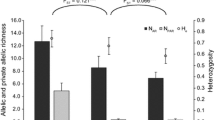Abstract
Populations of the harpacticoid copepod Tigriopus californicus were sampled from five sites from San Diego, California, to Playa Altamira, Baja California, Mexico. Allozyme analyses revealed that all the study populations are sharply differentiated genetically. At the extreme, two populations, Punta Baja and Playa Altamira, have no alleles in common at the seven allozyme loci studied. All pairwise interpopulation crosses successfully produced F2 hybrids except those involving the Playa Altamira population. All crosses using Playa Altamira females failed to produce F1 hybrids, while Playa Altamira males successfully produced F1 progeny with females from all other sites. These F1 offspring, however, were completely sterile (with San Diego and Punta Banda females) or only occasionally produced F2 offspring (with Punta Morro and Punta Baja females). These results suggest that allopatric differentiation among Baja populations has resulted in exceptionally high levels of genetic divergence and nearly complete reproductive isolation of the Playa Altamira population, which should now be recognized at the semispecies (or perhaps sibling species) level.
Similar content being viewed by others
References
Addicott WO (1966) Late Pleistocene marine paleoecology and zoogeography in central California. Prof Pap US geol Surv 523C: 1–21
Battaglia B (1982) Genetic variation and speciation events in marine copepods. In: Barigozzi C (ed) Mechanisms of speciation. Alan R. Liss, New York, pp 377–392
Bozic B (1960) Legenre Tigriopus Norman (copépodes harpacticoides) et ses formes européenes recherches morphologiques et expérimentales. Archs Zool exp gén 98: 167–269
Brown AF (1991) Outbreeding depression as a cost of dispersal in the harpacticoid copepod, Tigriopus californicus. Biol Bull mar biol Lab, Woods Hole 181: 123–126
Brusca RC, Wallerstein BR (1979) Zoogeographic patterns of idoteid isopods in the Northeast Pacific, with a review of the shallow water zoogeography of the area. Bull biol Soc Wash 3: 67–105
Bulnheim H-P, Scholl A (1981) Genetic variation between geographic populations of the amphipods Gammarus zaddachi and G. salinus. Mar Biol 64: 105–115
Burton RS (1985) Mating system of the intertidal copepod Tigriopus californicus. Mar Biol 86: 247–252
Burton RS (1986) Evolutionary consequences of restricted gene flow among natural populations of the copepod Tigriopus californicus. Bull mar Sci 39: 526–535
Burton RS (1987) Differentiation and integration of the genome in populations of the marine copepod, Tagriopus californicus. Evolution 41: 504–513
Burton RS (1990a) Hybrid breakdown in physiological response: a mechanistic approach. Evolution 44: 1806–1813
Burton RS (1990b) Hybrid breakdown in development time in the copepod Tigriopus californicus. Evolution 44: 1814–1822
Burton RS, Lee B-N (1994) Nuclear and mitochondrial gene genealogies and allozyme polymorphism across a major phylogeographic break in the copepod Tigriopus californicus. Proc natn Acad Sci USA 91: 5197–5201
DeSalle R, Hunt J (1987) Molecular evolution in Hawaiian drosopholids. Trends Ecol Evolut 2: 212–216
Dobzhansky T (1970) Genetics of the evolutionary process. Columbia University Press, New York
Ebert TA, Russell MP (1988) Latitudinal variation in size structure of the west coast purple sea urchin: a correlation with headlands. Limnol Oceanogr 33: 286–294
Endler JA (1977) Geographic variation, speciation, and clines. Sprinceton University Press, Princeton, New Jersey
Fava G, Battaglia B (1985) Processes of differentiation between Mediterranean populations of the superspecies Tisbe clodiensis Battaglia and Fava (1968) Copepoda. In: Moraitou-Apostolopoulou M, Kiortsis V (eds) Mediterranean marine ecosystems. Plenum, New York, pp 335–346
Fleminger A (1975) Geographical distribution and morphological divergence in American coastal-zone planktonic copepods of the genus Labidocera. In: Cronin, LE (ed) Estuarine research. 1. Chemistry, biology and the estuarine system. Academic Press, New York, pp 392–419
Harris H, Hopkinson DA (1976) Handbook of enzyme electrophoresis in human genetics. North-Holland, Amsterdam
Knowlton N (1993) Sibling species in the sea. A Rev Ecol Syst 24: 189–216
Kornfield IL, (1978) Evidence for rapid speciation in African cichlid fishes. Experientia 34: 335–336
Laguna JE (1990) Shore barnacles (Cirripedia, Thoracica) and a revision of their provincialism and transition zones in the Tropical Eastern Pacific. Bull mar Sci 46: 406–424
Lessios HA, Cunningham CW (1990) Gametic incompatibility between species of the sea urchin Echinometra on the two sides of the Isthmus of Panama. Evolution 44: 933–941
Mayr E (1970) Populations, species, and evolution. Harvard University Press, Cambridge, Massachusetts
Monk CR (1941) Marine harpacticoid copepods from California. Trans Am microsc Soc 60: 75–99
Mueller LD, Ayala FJ (1982) Estimation and interpretation of genetic distance in empirical studies. Genet Res 40: 127–137
Palumbi SR, Metz EC (1991) Strong reproductive isolation between closely related tropical sea urchins (genus Echinometra). Molec Biol Evolut 8: 227–239
Thorpe JP (1983) Enzyme variation, genetic distance and evolutionary divergence in relation to taxonomic separation. In: Oxford GS, Rollinson D (eds) Protein polymorphism: adaptive and taxonomic significance. Academic Press, New York, pp 131–152
Author information
Authors and Affiliations
Additional information
Communicated by M. F. Strathmann, Friday Harbor
Rights and permissions
About this article
Cite this article
Ganz, H.H., Burton, R.S. Genetic differentiation and reproductive incompatibility among Baja California populations of the copepod Tigriopus californicus . Marine Biology 123, 821–827 (1995). https://doi.org/10.1007/BF00349126
Received:
Accepted:
Issue Date:
DOI: https://doi.org/10.1007/BF00349126




